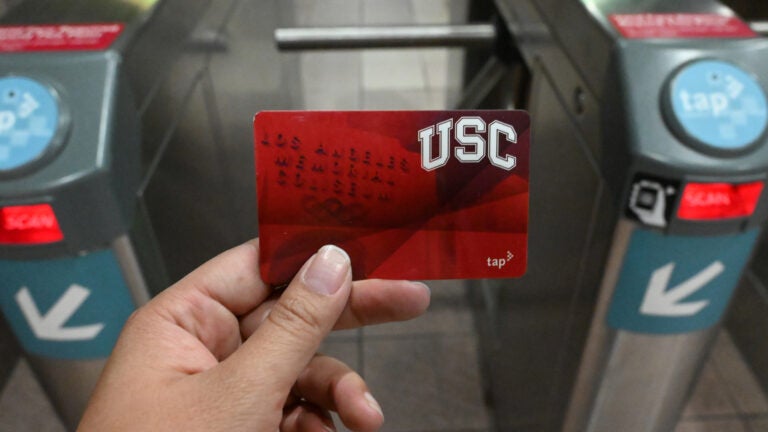
USC employees can sign up online for the public transit subsidy or purchase discounted passes in person at the USC Transportation services office. (USC Photo/Susanica Tam)
USC launches new public transit subsidy program for employees
Faculty and staff will receive a 50% subsidy on the cost of bus and rail passes, which restores and improves upon the previous benefit.
After a four-year hiatus, USC employees are once again being given an incentive to take the bus or rail to work.
The new program, which offers a 50% transit subsidy for not driving to campus, improves upon the previous subsidy that was discontinued in 2015 and is intended to reduce the number of single-passenger cars on the road during peak commuting hours.
The transit subsidy is available to all USC employees in the United States, regardless of whether they work at one of the two main campuses or a satellite office across the country. This employee program complements the existing options for graduate and undergraduate students, and helps faculty and staff also enjoy discounted access to public transit.
Choosing public transit is a great way to positively impact our environment on a daily basis.
Carol L. Folt
“One common request I heard during my listening tours was how much our staff and faculty wanted their transit subsidy back,” said Carol L. Folt, president of USC. “I’m especially thankful to our employees in the HR community for expressing their wishes, and that we could quickly restore and improve upon the program. Choosing public transit is a great way to positively impact our environment on a daily basis.”
USC Transportation will offer L.A. Metro Employer Passes (E-Passes) that include the use of all Metro rail, Metro local buses and Metro Rapid buses, as well as LADOT DASH, Culver City and Pasadena Transit municipal buses, with more agencies being added in the near future. The subsidy can also be applied to L.A. Metro EZ Transit, Commuter Express and Metrolink passes.
For example, the L.A. Metro E-Pass costs $80 for employees, which will then be subsidized 50% by the university. Metrolink passes are available for a 25% discount, with the transit subsidy further reducing the cost. The passes must be purchased through the USC Transportation services office, and employees can pay for the passes with payroll deductions in pre-tax dollars, providing even greater value to staff and faculty (employees should visit the USC Faculty and Staff Transit Subsidy webpage for more details around tax implications). The previous program, discontinued in 2015, was capped at $30 per person per month, regardless of program cost or riding distance.
“This new transit subsidy program provides greater incentive to employees to make different choices around how they commute,” said David Wright, USC’s senior vice president of administration. “We are initially aiming for 2,000 members of the Trojan Family to take advantage of Los Angeles’ highly accessible public transit system and hope even more will make this choice.”
Employees who wish to participate in the public transit subsidy program can sign up online at the USC Transportation website. The deadline to receive the subsidy for October is Sept. 24. Employees in the Los Angeles basin who sign up before then will receive their subsidy and pass for L.A. Metro, LADOT and Metrolink transit services for October; those outside the Los Angeles basin will receive their subsidy once agreements with their local transit agencies are finalized.
“Metro’s E-Pass Program makes transit easier to ride for employees, by providing unlimited boardings on multiple transit agencies,” said Phillip Washington, CEO of Los Angeles County Metropolitan Transportation Authority. “The E-Pass has increased transit riders by participating employers up to 15%.”
The USC transportation subsidy is the first step in a comprehensive transportation demand management plan that will be included in the Sustainability 2028 Plan currently in development. Transportation demand management is an essential part of modern urban planning. At its simplest level, it is about providing travelers with additional commuting options; this is most frequently used in an effort to minimize the number of cars on the road, especially single-passenger vehicles. The EPA estimates that each passenger vehicle generates an average of 4.7 metric tons of CO2 emissions per year. Two thousand fewer cars on the road would reduce CO2 emissions by 9,400 metric tons per year. This is roughly equal to the carbon sequestered by 415,000 trees per year.



